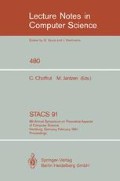Abstract
Trace languages are used in computer science to provide a description of the behaviours of concurrent systems. If we are interested in systems which never stop then we have to consider languages of infinite traces. In this paper, we introduce and study recognizable and rational languages of finite and infinite traces. We characterize recognizable languages by means of a syntactic congruence. We prove that the family of recognizable languages is strictly included in the family of rational languages. Next, we study the closure properties of the family of recognizable languages. We prove that this family is closed under the Boolean operations and under concatenation. Contrary to the (finite) iteration, the infinite iteration of a finite trace is proved to be recognizable. We conclude this paper with some open problems.
This work has been supported by the ESPRIT Basic Research Action No. 3166: Algebraic and Syntactic Methods in Computer Science (ASMICS) and by the PRC Math-Info.
Preview
Unable to display preview. Download preview PDF.
5. References
A. ARNOLD, “A syntactic congruence for rational ω-languages”, Theoretical Computer Science 39, p. 333–335, 1985.
I.J. AALBERSBERG and G. ROZENBERG, “Theory of traces”, Theoretical Computer Science 60, p. 1–82, 1988.
J.R. BUCHI, “On a decision method in restricted second order arithmetic”, Proc. Internat. Congress on Logic, Methodology and Philosophy (Standford University Press), p. 1–11, 1962.
P. CARTIER and D. FOATA, “Problèmes combinatoires de commutation et réarrangements”, Lecture Notes in Math. 85, 1969.
R. CORI and Y. METIVIER, “Recognizable subsets of some partially abelian monoids”, Theoretical Computer Science 35, p. 179–189, 1985.
R. CORI and D. PERRIN, “Automates et commutations partielles”, RAIRO Theoretical Informatics and Applications 19, p. 21–32, 1985.
V. DIEKERT, “Combinatorics on Traces”, Lecture Notes in Computer Science 454, 1990.
S. EILENBERG, “Automata, Languages and Machines”, Academic Press, New York, 1974.
M. FLIESS, “Matrices de Hankel”, J. Math. pures et appl. 53, p. 197–224, 1974.
M.P. FLE and G. ROUCAIROL, “Maximal serializability of iterated transactions”, Theoretical Computer Science 38, p. 1–16, 1985.
P. GASTIN, “Un modèle asynchrone pour les systèmes distribués”, Theoretical Computer Science 74, p. 121–162, 1990.
P. GASTIN, “Infinite traces”, Proceedings of the Spring School of Theoretical Computer Science on “Semantics of concurrency”, Lecture Notes in Computer Science 469, 1990.
R. L. GRAHAM, “Rudiments of Ramsey theory”, Regional conference series in mathematics 45, 1981.
P. GASTIN and B. ROZOY, “The Poset of infinitary traces”, Tech. Rep. 90-24, LITP, Université Paris 6, France, 1990.
H.J. HOOGEBOOM and G. ROZENBERG, “Infinitary languages: basic theory and applications to concurrent systems”, Lecture Notes in Computer Science 224, p. 266–342, 1986.
M.Z. KWIATKOWSKA, “On infinitary trace languages”, Tech. Rep. 31, University of Leicester, England, 1989.
M. LOTHAIRE, “Combinatorics on words”, Addison Wesley, 1983.
A. MAZURKIEWICZ, “Trace theory”, Advanced Course on Petri Nets, Lecture Notes in Computer Science 255, p. 279–324, 1986.
Y. METIVIER, “Une condition suffisante de reconnaissabilité dans un monoïde partiellement commutatif”, RAIRO Theoretical Informatics and Applications 20, p. 121–127, 1986.
Y. METIVIER, “On recognizable subsets in free partially commutative monoids”, ICALP 1986, Lecture Notes in Computer Science 226, p. 254–264, 1986.
D.E. MULLER, “Infinite sequences and finite machines”, Proc. 4th IEEE Ann. Symp. on Switching Circuit Theory and Logical Design, p. 3–16, 1963.
E. OCHMANSKI, “Regular behaviour of concurrent systems”, Bulletin of EATCS 27, p. 56–67, October 1985.
D. PERRIN, “Partial commutations”, ICALP 89, Lecture Notes in Computer Science 372, p. 637–651, 1989.
D.PERRIN and J.E. PIN, “Mots Infinis”, Tech. Rep., LITP, Université Paris 6, France, 1990. Book to appear.
B. ROZOY, “On Traces, Partial Order Sets and Recognizability”, ISCIS V, Cappadocia, Turkey, proceedings to appear, 1990.
J. SAKAROVITCH, “On regular trace languages”, Theoretical Computer Science 52, p. 59–75, 1987.
W. THOMAS, “Automata on infinite objects”, to appear in Handbook of Theoretical Computer Science (J.V. Leeuwen, Ed.), North-Holland, Amsterdam.
W. THOMAS, “On logical definability of trace languages”, Proceedings of the ASMICS Workshop on Partially Commutative Monoids, Tech. Rep. TUM-I 9002, Technische Universität München, 1989.
W. ZIELONKA, “Notes on finite asynchronous automata and trace languages”, RAIRO Theoretical Informatics and Applications 21, p. 99–135, 1987.
W. ZIELONKA, “Safe execution of recognizable trace Languages by asynchronous automata”, Lecture Notes in Computer Science 363, p. 278–289, 1989.
Author information
Authors and Affiliations
Editor information
Rights and permissions
Copyright information
© 1991 Springer-Verlag Berlin Heidelberg
About this paper
Cite this paper
Gastin, P. (1991). Recognizable and rational languages of finite and infinite traces. In: Choffrut, C., Jantzen, M. (eds) STACS 91. STACS 1991. Lecture Notes in Computer Science, vol 480. Springer, Berlin, Heidelberg. https://doi.org/10.1007/BFb0020790
Download citation
DOI: https://doi.org/10.1007/BFb0020790
Published:
Publisher Name: Springer, Berlin, Heidelberg
Print ISBN: 978-3-540-53709-0
Online ISBN: 978-3-540-47002-1
eBook Packages: Springer Book Archive

